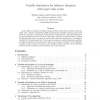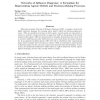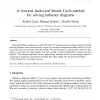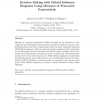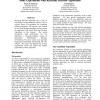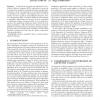84
Voted
IJAR
2010
14 years 10 months ago
2010
In the original formulation of influence diagrams (IDs), each model contained exactly one utility node. Tatman and Shachter (1990), introduced the possibility of having super-valu...
107
Voted
JAIR
2008
15 years 19 days ago
2008
This paper presents Networks of Influence Diagrams (NID), a compact, natural and highly expressive language for reasoning about agents' beliefs and decision-making processes....
91
Voted
IJAR
2006
15 years 19 days ago
2006
Although influence diagrams are powerful tools for representing and solving complex decisionmaking problems, their evaluation may require an enormous computational effort and this...
EOR
2008
15 years 21 days ago
2008
Mixtures of truncated exponentials (MTE) potentials are an alternative to discretization for representing continuous chance variables in influence diagrams. Also, MTE potentials c...
83
Voted
UAI
1996
15 years 1 months ago
1996
Real-time Decision algorithms are a class of incremental resource-bounded [Horvitz, 89] or anytime [Dean, 93] algorithms for evaluating influence diagrams. We present a test domai...
95
Voted
UAI
1994
15 years 1 months ago
1994
Most traditional models of uncertainty have focused on the associational relationship among variables as captured by conditional dependence. In order to successfully manage intell...
FLAIRS
1998
15 years 2 months ago
1998
The increasing number of knowledge-based systems that build on a Bayesian belief network or influence diagram acknowledge the usefulness of these frameworks for addressing complex...
91
Voted
ECAI
2006
Springer
15 years 4 months ago
2006
Springer
Abstract. In this article we present the framework of Possibilistic Influence Diagrams (PID), which allow to model in a compact form problems of sequential decision making under un...
